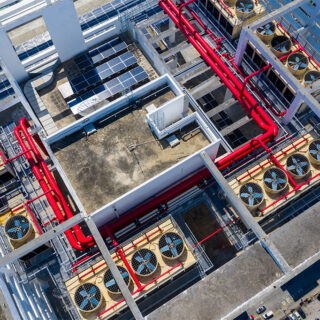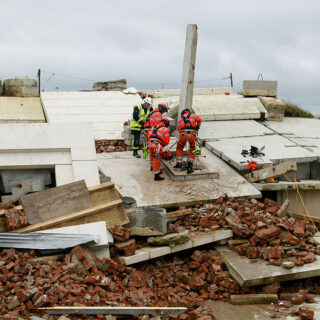Real Estate Due Diligence
Rimkus provides experienced resources to mitigate risks associated with real estate investments. We are invested in helping our clients navigate unique real estate challenges, and to do that most effectively, we make it our business to understand yours.

Operational Leadership
SERVICES
Our Real Estate Due Diligence Services
-
Property Condition Assessments
 We help maximize your property’s value by identifying key issues and providing custom solutions. Our architectural and engineering professionals create due diligence solutions backed by years of design and field oversight experience. With both your short- and long-term goals in mind, our multidisciplinary teams can provide you with detailed opinions as well as uncover deferred maintenance issues and defects that often elude more general assessments or walk-throughs. Each building is a unique project that requires a custom set of services. Rimkus does not provide out-of-the-box solutions; we provide a comprehensive plan that meets your project needs, budget, and scope. Our team includes registered architects, professional engineers, and construction specialists. Our specialty assessments include:
We help maximize your property’s value by identifying key issues and providing custom solutions. Our architectural and engineering professionals create due diligence solutions backed by years of design and field oversight experience. With both your short- and long-term goals in mind, our multidisciplinary teams can provide you with detailed opinions as well as uncover deferred maintenance issues and defects that often elude more general assessments or walk-throughs. Each building is a unique project that requires a custom set of services. Rimkus does not provide out-of-the-box solutions; we provide a comprehensive plan that meets your project needs, budget, and scope. Our team includes registered architects, professional engineers, and construction specialists. Our specialty assessments include:- Mechanical/Electrical/Plumbing (MEP)
- Fire and Life-Safety Systems
- Structural
- Seismic
- Exterior Cladding/Facade
- Roofing
- Vertical Transportation
- Fair Housing (FHAA) and ADA
- Wood-Destroying Organisms
- BOMA Building Area Calculation
- Public Records and Zoning Report
-
Environmental Site Assessments
 We help protect asset value with comprehensive environmental risk assessment and creative problem solving. Rimkus exceeds industry standards for environmental assessments, including ASTM E1527, Standard Practice for Environmental Site Assessments: Phase I Environmental Site Assessment Process (Phase I ESAs). Our Phase I ESA services include the following assessments:
We help protect asset value with comprehensive environmental risk assessment and creative problem solving. Rimkus exceeds industry standards for environmental assessments, including ASTM E1527, Standard Practice for Environmental Site Assessments: Phase I Environmental Site Assessment Process (Phase I ESAs). Our Phase I ESA services include the following assessments:- Detailed Site Inspection
- Regulatory Database, Aerial Photograph, and Historical Map Reviews
- Interviews with Persons Knowledgeable of the Site
- Evaluation of Risks of Neighboring Properties
- Review of Previous Site Evaluations or Other Reports
- Presentation of Reasonable Conclusions and Opinions
- Soil and Groundwater
- Soil Gas/Vapor
- Lead-Based Paint
- Water Potability and Indoor Air Quality/Mold
- Asbestos
- Radon
- Geophysical Surveying
- PCB/Metals Wipe
-
Seismic Risk Consulting
 Rimkus engineers are seismic risk experts and key seismic policy advisors. Rimkus’s structural engineers have conducted thousands of seismic risk assessments of commercial properties in the seismically active regions of North and South America and the U.S. Virgin Island Territories. Our team is fully qualified under the updated E2016-16 and E2557-16 ASTM standards, and has 30+ years of seismic risk expertise, including transactional seismic risk assessment reports in conformance with:
Rimkus engineers are seismic risk experts and key seismic policy advisors. Rimkus’s structural engineers have conducted thousands of seismic risk assessments of commercial properties in the seismically active regions of North and South America and the U.S. Virgin Island Territories. Our team is fully qualified under the updated E2016-16 and E2557-16 ASTM standards, and has 30+ years of seismic risk expertise, including transactional seismic risk assessment reports in conformance with:- ASTM E2026-16 (Standard Guide for Seismic Risk Assessment of Buildings)
- ASTM E2557-16 (Standard Practice for Probable Maximum Loss PML Evaluations for Earthquake Due Diligence Assessments)
- Level 0 — Desktop Investigations
- Level 1 — Engineering Investigations for Lenders and Owners
- Level 2 and 3 — Sophisticated Structural Analysis with Conceptual Seismic Retrofit Schematic Design
- Tier 1 and 2 Seismic Evaluatoins Using the American Society of Civil Engineers National Standard ASCE 41-13 (Seismic Evaluation and Retrofit Rehabilitation of Existing Buildings)
- Fannie Mae and Freddie Mac Agency Seismic Reports
- Acquisition Seismic Due Diligence
- Disposition Seismic Due Diligence
- Structural Condition Assessments and Remediation Design
- HUD MAP Guide Multifamily Seismic Risk Evaluations Using ASCE 41-13
- U.S. General Services Administration (GSA) and California Department of General Services (DGS) Government Tenants/Owners
-
Natural Resource Consulting
 Our Natural Resource Consulting team is committed to providing high quality scientific and engineering services. Our highly trained technical consultants develop innovative solutions that meet specific needs consistent with the long-term interests of the industry, the public, and the environment. We maintain high standards of professional conduct and comply with all applicable rules and regulations relating to our work. Being true experts in the Natural Resource and Environmental Consulting field allows us to think outside of the box to find the most practical, cost-effective solutions to project challenges.
Our Natural Resource Consulting team is committed to providing high quality scientific and engineering services. Our highly trained technical consultants develop innovative solutions that meet specific needs consistent with the long-term interests of the industry, the public, and the environment. We maintain high standards of professional conduct and comply with all applicable rules and regulations relating to our work. Being true experts in the Natural Resource and Environmental Consulting field allows us to think outside of the box to find the most practical, cost-effective solutions to project challenges.
Natural Resource Services:- Waters of the U.S. (WOTUS) and State Waters
- Preliminary Wetland and State Water Assessments
- Wetland Identification and Delineation
- U.S. Army Corps of Engineers/Issuing Authority coordination and negotiation
- Clean Water Act Permitting
- Nationwide and individual permit preparation, planning, and negotiation
- Threatened/Endangered Species Assessments and Section 7 consultation
- Terrestrial/aquatic species
- WOTUS and State Waters Sediment Discharge Evaluations
- Pond/Lake Baseline and Post-Construction Evaluations: Sedimentation Loading
- Mitigation Planning
- Historical/Cultural Resources Assessments and Section 106 consultation
- Mitigation banking and planning
- Wetland restoration, enhancement, and monitoring
- Hazardous Building Material Investigations
- Asbestos Pre-Demolition Surveys
- Lead-based Paint Screening
- Environmental Site Assessments (ESAs)
- Phase I ESAs (E1527)
- ASTM E-1528 Environmental Transaction Screens
- Environmental Risk Assessments
- National Environmental Policy Act and Georgia Environmental Policy Act audits
- Subsurface Investigations and Assessments
- Phase II Limited Site Investigations
- Soil and Groundwater Remediation
- Georgia Hazardous Site Response Act
- Georgia Brownfield Act
- Underground Storage Tanks
- Assessments and closures
- Corrective Action Plan preparation
- Waters of the U.S. (WOTUS) and State Waters
Our Real Estate Due Diligence Experts
John Bruzzese, MCPPO, CSL
Construction Science Practice Leader
Fewzi Fardeheb, R.A., NCARB
Real Estate Due Diligence Practice Leader
Peter J. Galoski
Vice President, Environmental Services Practice
Brian M. Wyllie, P.E.
Electrical Engineering Practice Leader
CLIENT RESOURCES
Related Case Studies


Environmental Site Assessment On An Industrial Warehouse Building
READ MORE